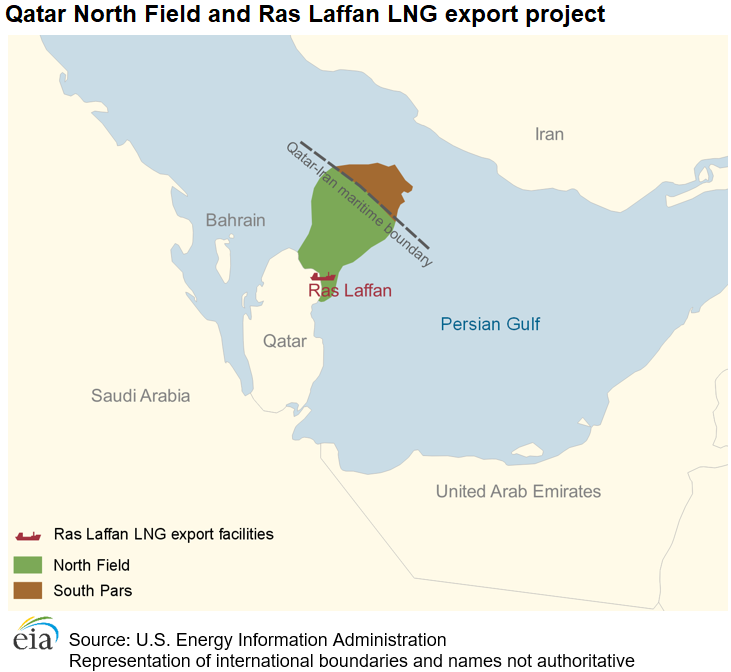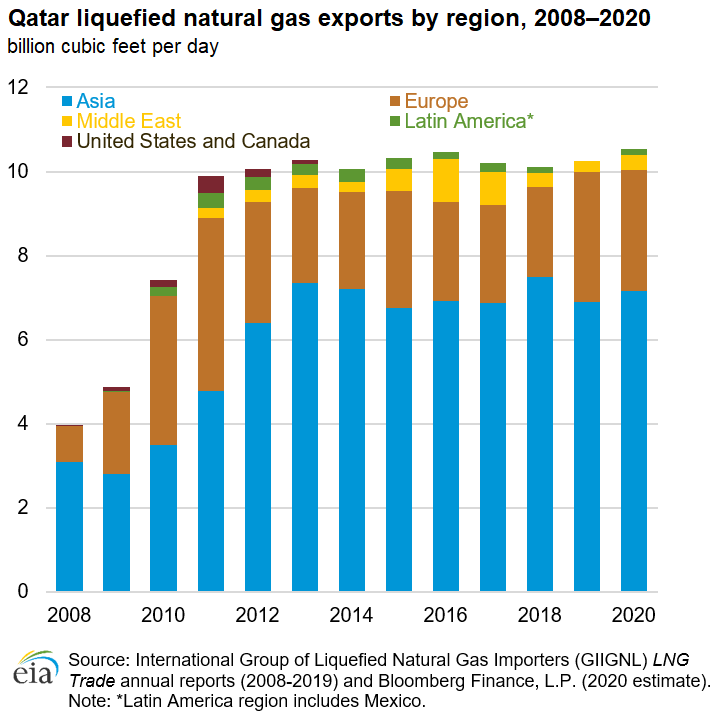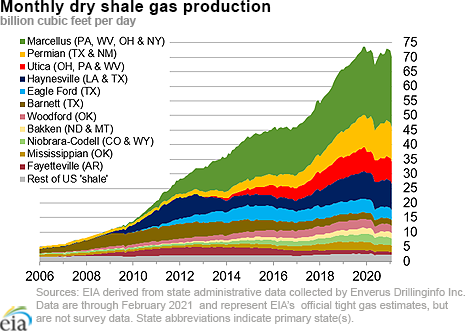In the News:
Qatar Petroleum makes final investment decision to expand Ras Laffan LNG export project
Last month, Qatar Petroleum—the majority owner of the Ras Laffan Liquefied Natural Gas (LNG) export project in Qatar—made its final investment decision to expand the facility by constructing four LNG liquefaction units (called trains), each with a capacity of 8 million metric tons per annum (mtpa), or 1.05 billion cubic feet per day (Bcf/d). Trains of this size have the largest LNG production capacity in the world and are called “mega trains.” Globally, six LNG mega trains are operating, all located in Qatar at Ras Laffan industrial city, with a combined LNG production capacity of 46.8 mtpa (6.2 Bcf/d). The remaining eight LNG trains at Ras Laffan have lower per-unit output and a combined LNG production capacity of 30.2 mtpa (4 Bcf/d).
Qatar has been the world’s largest LNG exporter since 2006. Qatar sources natural gas for LNG exports from the world’s largest non-associated natural gas field, called North Field, which Qatar shares with Iran (called South Pars on the Iranian side). In 2017, Qatar ended a moratorium on further development of new natural gas production from the North Field, which had been in place since 2005, and started developing several expansion projects.
The North Field expansion is planned in two phases. The first phase will include development of 6 Bcf/d of North Field’s natural gas-producing reservoirs located in the east part of the producing region called North Field East (NFE). This NFE expansion will increase the existing Ras Laffan LNG production capacity from 77 mtpa (10.1 Bcf/d) to 110 mtpa (14.5 Bcf/d) by 2025. The second phase of the expansion—which will develop the North Field South (NFS) offshore reservoirs—will include two additional LNG mega trains, each with a capacity of 8 mtpa (1.1 Bcf/d). The NFS phase will further expand Ras Laffan’s LNG export capacity to 126 mtpa (16.6 Bcf/d) and is expected to be completed by 2027.
The expansion project will also include construction of three LNG storage tanks and three additional loading berths for the NFE expansion phase, along with associated LNG production facilities. The second phase for the NFS project has an option for two additional LNG storage tanks and one LNG berth, as well as associated pipelines and other facilities.
The estimated cost of the NFE expansion project is $28.75 billion. In February 2021, Qatar Petroleum awarded the engineering, procurement, and construction (EPC) contract to a joint venture of Chiyoda and Technip Energies for $13 billion. Qatar Petroleum has signed several Sales and Purchase Agreements (SPAs) with Pakistan, Bangladesh, and China, among others, for the off-take volumes from the expansion project.
The Ras Laffan LNG expansion project is designed to reduce its carbon footprint and greenhouse gas (GHG) emissions by sourcing electricity in part from the Al Kharsaah Solar Power Project, building a carbon capture and sequestration (CCS) facility and a system to recover jetty boil-off natural gas, and implementing several other emissions reduction measures.
Historically, Asia has been the main destination for Qatar’s LNG exports, followed by Europe, the Middle East, and Latin America. In 2020, LNG exports from Qatar went to a total of 22 countries around the world, with India accounting for the largest volume of Qatar’s LNG exports, followed by Japan, South Korea, China, United Kingdom, Pakistan, and Taiwan, according to shipping data provided by Bloomberg Finance, L.P.
Overview:
(For the week ending Wednesday, March 24, 2021)
- Natural gas spot prices fell at most locations this report week (Wednesday, March 17 to Wednesday, March 24), as heating demand continues to decline and dry natural gas production reaches the highest level since the first week of January. The Henry Hub spot price fell from $2.51 per million British thermal units (MMBtu) last Wednesday to $2.45/MMBtu yesterday.
- At the New York Mercantile Exchange (NYMEX), the price of the April 2021 contract decreased 1¢, from $2.528/MMBtu last Wednesday to $2.518/MMBtu yesterday. The price of the 12-month strip averaging April 2021 through March 2022 futures contracts climbed 2¢/MMBtu to $2.750/MMBtu.
- The net withdrawals from working gas totaled 36 billion cubic feet (Bcf) for the week ending March 19. Working natural gas stocks totaled 1,746 Bcf, which is 13% lower than the year-ago level and 4% lower than the five-year (2016–2021) average for this week.
- The natural gas plant liquids (NGPL) composite price at Mont Belvieu, Texas, fell by 44¢/MMBtu, or 5.6%, averaging $7.46/MMBtu for the week ending March 24, mirroring a 5.6% decline in West Texas Intermediate (WTI) crude oil prices for the same week. The prices of natural gasoline, butane, and isobutane, which are most closely correlated with crude oil, fell by 10%, 8%, and 7%, respectively. Recovering petrochemical industry feedstock demand supported ethane and propane prices, which fell by less than other NGPLs. The average weekly ethane price declined by 1%, and the average weekly propane price declined by 4%.
- According to Baker Hughes, for the week ending Tuesday, March 16, the natural gas rig count remained flat at 92. The number of oil-directed rigs rose by 9 to 318. Oil-directed rigs have reached the highest level since the first week of May 2020. The total rig count increased by 9, and it now stands at 411.
Prices/Supply/Demand:
Prices in most markets decline week over week as heating season draws to an end and the rate of natural gas inventory draws decreases. This report week (Wednesday, March 17 to Wednesday, March 24), the Henry Hub spot price fell 6¢ from $2.51/MMBtu last Wednesday to $2.45/MMBtu yesterday.
Prices fell in the Midwest, as warmer-than-normal weather, particularly in the Great Lakes region, caused a decline in space heating demand. Average weekly Midwest temperatures averaged 2ºF to 12ºF above the 30-year average for this time of year. Later in the report week, Chicago temperatures reached the mid- to upper-50’s, on average 14ºF above the 30-year average. At the Chicago Citygate, the price decreased 9¢ from $2.43/MMBtu last Wednesday to $2.34/MMBtu yesterday.
Prices in California vary as PG&E Citygate prices rose and SoCal Citygate prices declined this report week. Temperatures across the West, including all of California, were significantly below average late in the report week, resulting in unseasonably high heating demand across the region. The natural gas price at PG&E Citygate in Northern California rose 2¢, up from $3.60/MMBtu last Wednesday to a weekly high of $3.62/MMBtu yesterday, after falling to $3.46/MMBtu on Friday. The price at SoCal Citygate in Southern California decreased 27¢ from $3.24/MMBtu last Wednesday to $2.97/MMBtu yesterday. SoCal Citygate prices were lowest on Monday and Tuesday, when they fell to $2.71/MMBtu. On March 22, El Paso Natural Gas announced it was lifting the force majeure at the Topock Compressor Station, which was declared on March 8 and restricted the flow of natural gas to markets in Southern California.
Prices across the Northeast decline significantly week over week. At the Algonquin Citygate, which serves Boston-area consumers, the price went down 83¢ from $2.76/MMBtu last Wednesday to $1.93/MMBtu yesterday, after hitting a weekly high of $3.45/MMBtu on Thursday. At the Transcontinental Pipeline Zone 6 trading point for New York City, the price decreased 46¢ from $2.25/MMBtu last Wednesday to $1.79/MMBtu yesterday after reaching a weekly high of $2.42/MMBtu on Thursday.
Prices in the Appalachia Basin-producing region decline in response to falling demand due to rising temperatures. Prices at major trading points in the Appalachia Basin fell steadily through the week, reaching weekly lows on Wednesday. The Tennessee Zone 4 Marcellus spot price decreased 32¢ from $2.00/MMBtu last Wednesday to $1.68/MMBtu yesterday. The price at Dominion South in southwest Pennsylvania fell 33¢ from $2.08/MMBtu last Wednesday to $1.75/MMBtu yesterday.
Prices in the Permian production region decrease slightly as production continues to recover. The price at the Waha Hub in West Texas, which is located near Permian Basin production activities, averaged $2.36/MMBtu last Wednesday, 15¢/MMBtu lower than the Henry Hub price. Yesterday, the price at the Waha Hub averaged $2.31/MMBtu, 14¢/MMBtu lower than the Henry Hub price and a 5¢/MMBtu decline week over week. Prices at the Waha Hub fell as low as $2.15/MMBtu on Friday, the lowest level since December 28, 2020.
U.S. production continues to rise. According to data from IHS Markit, the average total supply of natural gas rose by 0.1% compared with the previous report week. Dry natural gas production grew by 0.4% compared with the previous report week to average more than 91.1 Bcf/d, the highest level since the first week of January. Production growth was strongest in the Rockies, where the prior week’s output was depressed as a result of well freeze-offs caused by low temperatures and a major snowfall in the region. Average net imports from Canada decreased by 4.8% from last week.
U.S. demand continues to decline as the heating season comes to a close. Total U.S. consumption of natural gas fell by 5.6% compared with the previous report week, according to data from IHS Markit. Natural gas consumed for power generation declined by 2.7% week over week. In the residential and commercial sectors, consumption declined by 12.9%. Industrial sector consumption increased by 0.1% week over week as industrial activity continued to recover from the effects of a winter storm from February 13 through February 17, which shuttered much of the U.S. Gulf Coast petrochemical industry. Natural gas exports to Mexico increased 6.1%. Natural gas deliveries to U.S. liquefied natural gas (LNG) export facilities (LNG pipeline receipts) averaged 11.6 Bcf/d, or 0.58 Bcf/d higher than last week.
U.S. LNG exports increase week over week. Nineteen LNG vessels (seven from Sabine Pass, four each from Cameron and Corpus Christi, three from Freeport, and one from Cove Point) with a combined LNG-carrying capacity of 71 Bcf departed the United States between March 18 and March 24, 2021, according to shipping data provided by Bloomberg Finance, L.P.
Storage:
The net withdrawals from storage totaled 36 Bcf for the week ending March 19, compared with the five-year (2016–2021) average net withdrawals of 51 Bcf and last year's net withdrawals of 26 Bcf during the same week. Working natural gas stocks totaled 1,746 Bcf, which is 78 Bcf lower than the five-year average and 263 Bcf lower than last year at this time.
According to The Desk survey of natural gas analysts, estimates of the weekly net change to working natural gas stocks ranged from net withdrawals of 8 Bcf to 33 Bcf, with a median estimate of 22 Bcf.
The average rate of withdrawals from storage is 15% higher than the five-year average so far in the withdrawal season (November through March). If the rate of withdrawals from storage matched the five-year average of 1.5 Bcf/d for the remainder of the withdrawal season, the total inventory would be 1,728 Bcf on March 31, which is 78 Bcf lower than the five-year average of 1,806 Bcf for that time of year.
More storage data and analysis can be found on the Natural Gas Storage Dashboard and the Weekly Natural Gas Storage Report.
See also:
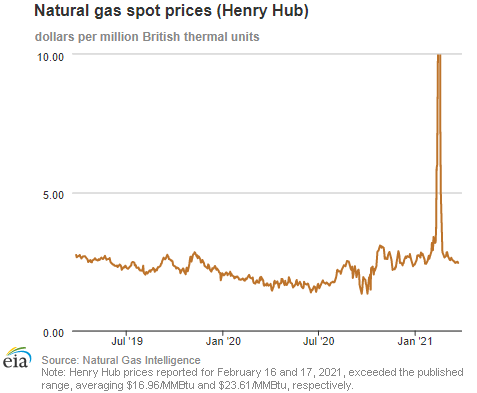
| Spot Prices ($/MMBtu) | Thu, 18-Mar |
Fri, 19-Mar |
Mon, 22-Mar |
Tue, 23-Mar |
Wed, 24-Mar |
|---|---|---|---|---|---|
| Henry Hub |
2.46 |
2.45 |
2.49 |
2.49 |
2.45 |
| New York |
2.42 |
2.02 |
1.91 |
2.04 |
1.79 |
| Chicago |
2.35 |
2.32 |
2.37 |
2.47 |
2.34 |
| Cal. Comp. Avg.* |
2.76 |
2.75 |
2.84 |
2.81 |
2.84 |
| Futures ($/MMBtu) | |||||
| April contract | 2.481 |
2.535 |
2.582 |
2.508 |
2.518 |
| May contract |
2.511 |
2.566 |
2.619 |
2.554 |
2.568 |
| *Avg. of NGI's reported prices for: Malin, PG&E Citygate, and Southern California Border Avg. | |||||
| Source: NGI's Daily Gas Price Index | |||||
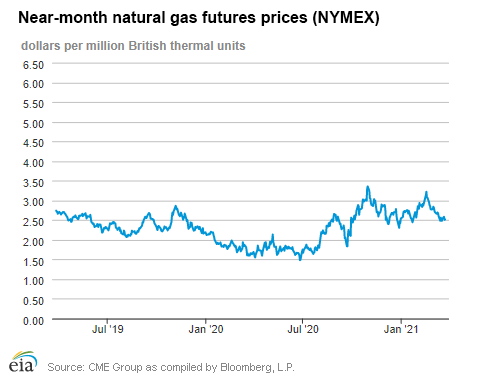
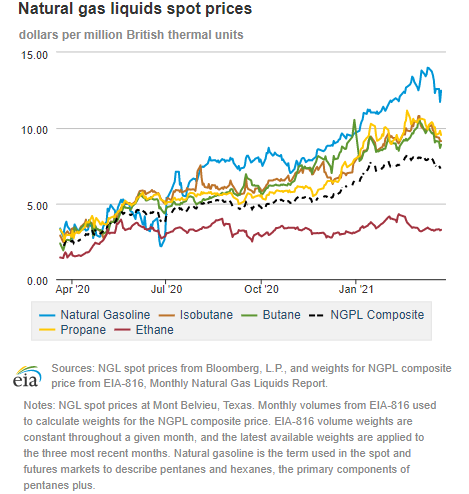
| U.S. natural gas supply - Gas Week: (3/18/21 - 3/24/21) | |||
|---|---|---|---|
Average daily values (Bcf/d): |
|||
this week |
last week |
last year |
|
| Marketed production | 103.1 |
102.7 |
107.3 |
| Dry production | 91.1 |
90.8 |
94.1 |
| Net Canada imports | 4.4 |
4.6 |
4.5 |
| LNG pipeline deliveries | 0.1 |
0.1 |
0.1 |
| Total supply | 95.6 |
95.5 |
98.6 |
|
Source: IHS Markit | |||
| U.S. natural gas consumption - Gas Week: (3/18/21 - 3/24/21) | |||
|---|---|---|---|
Average daily values (Bcf/d): |
|||
this week |
last week |
last year |
|
| U.S. consumption | 72.9 |
77.2 |
81.5 |
| Power | 24.4 |
25.1 |
29.2 |
| Industrial | 23.6 |
23.6 |
23.3 |
| Residential/commercial | 24.8 |
28.5 |
28.9 |
| Mexico exports | 6.0 |
5.6 |
5.4 |
| Pipeline fuel use/losses | 6.4 |
6.5 |
7.0 |
| LNG pipeline receipts | 11.6 |
11.1 |
8.6 |
| Total demand | 96.9 |
100.4 |
102.5 |
|
Source: IHS Markit | |||
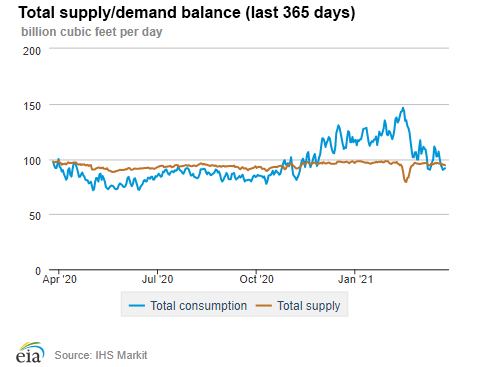
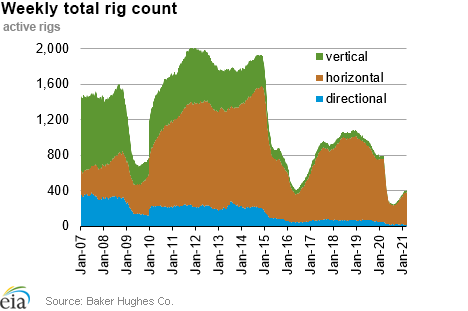
| Rigs | |||
|---|---|---|---|
Tue, March 16, 2021 |
Change from |
||
last week |
last year |
||
| Oil rigs | 318 |
2.9% |
-52.1% |
| Natural gas rigs | 92 |
0.0% |
-13.2% |
| Note: Excludes any miscellaneous rigs | |||
| Rig numbers by type | |||
|---|---|---|---|
Tue, March 16, 2021 |
Change from |
||
last week |
last year |
||
| Vertical | 25 |
0.0% |
-7.4% |
| Horizontal | 372 |
2.8% |
-46.6% |
| Directional | 14 |
-6.7% |
-71.4% |
| Source: Baker Hughes Co. | |||
| Working gas in underground storage | ||||
|---|---|---|---|---|
Stocks billion cubic feet (Bcf) |
||||
| Region | 2021-03-19 |
2021-03-12 |
change |
|
| East | 307 |
328 |
-21 |
|
| Midwest | 405 |
426 |
-21 |
|
| Mountain | 112 |
114 |
-2 |
|
| Pacific | 193 |
199 |
-6 |
|
| South Central | 730 |
715 |
15 |
|
| Total | 1,746 |
1,782 |
-36 |
|
|
Source: Form EIA-912, Weekly Underground Natural Gas Storage Report | ||||
| Working gas in underground storage | |||||
|---|---|---|---|---|---|
Historical comparisons |
|||||
Year ago (3/19/20) |
5-year average (2016-2020) |
||||
| Region | Stocks (Bcf) |
% change |
Stocks (Bcf) |
% change |
|
| East | 400 |
-23.3 |
329 |
-6.7 |
|
| Midwest | 495 |
-18.2 |
424 |
-4.5 |
|
| Mountain | 93 |
20.4 |
106 |
5.7 |
|
| Pacific | 195 |
-1.0 |
186 |
3.8 |
|
| South Central | 827 |
-11.7 |
778 |
-6.2 |
|
| Total | 2,009 |
-13.1 |
1,824 |
-4.3 |
|
| Source: Form EIA-912, Weekly Underground Natural Gas Storage Report | |||||
| Temperature – heating & cooling degree days (week ending Mar 18) | ||||||||
|---|---|---|---|---|---|---|---|---|
HDD deviation from: |
CDD deviation from: |
|||||||
| Region | HDD Current |
normal |
last year |
CDD Current |
normal |
last year |
||
| New England | 206 |
3 |
37 |
0 |
0 |
0 |
||
| Middle Atlantic | 185 |
-4 |
37 |
0 |
0 |
0 |
||
| E N Central | 177 |
-21 |
-3 |
0 |
0 |
0 |
||
| W N Central | 173 |
-24 |
-21 |
0 |
-1 |
0 |
||
| South Atlantic | 81 |
-30 |
14 |
16 |
5 |
-2 |
||
| E S Central | 47 |
-59 |
-22 |
7 |
2 |
3 |
||
| W S Central | 28 |
-36 |
-3 |
24 |
13 |
-5 |
||
| Mountain | 187 |
28 |
40 |
0 |
-1 |
0 |
||
| Pacific | 133 |
43 |
20 |
0 |
-1 |
0 |
||
| United States | 142 |
-7 |
11 |
6 |
2 |
-1 |
||
|
Note: HDD = heating degree day; CDD = cooling degree day Source: National Oceanic and Atmospheric Administration | ||||||||
Average temperature (°F)
7-day mean ending Mar 18, 2021
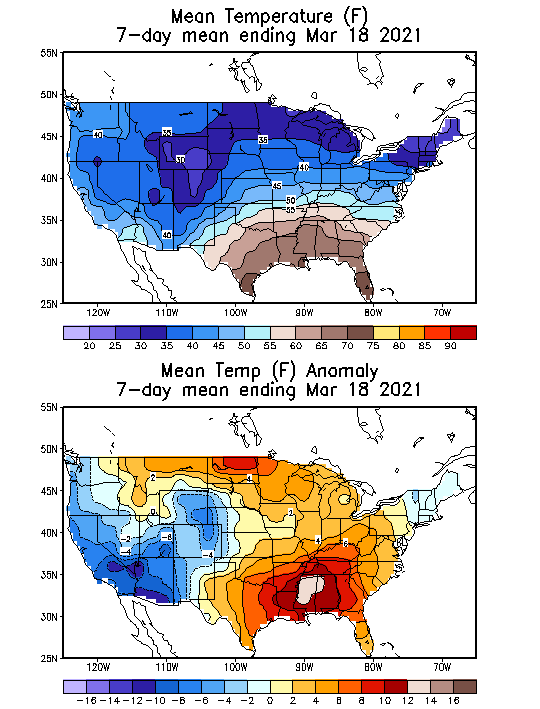
Source: National Oceanic and Atmospheric Administration
Deviation between average and normal (°F)
7-day mean ending Mar 18, 2021

Source: National Oceanic and Atmospheric Administration

